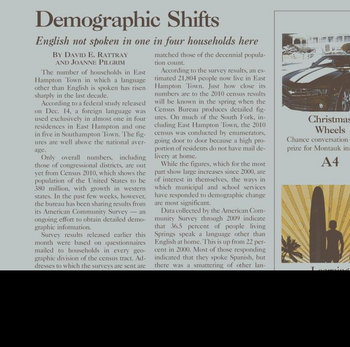The 2010 census saw the most dramatic shift in the U.S. Census Bureau's data collection process in decades. The successful launch of the American Community Survey (ACS), which is administered continuously throughout the decade, meant that the long-form sample questionnaire was no longer used in the census itself. Unlike the decennial census, the ACS is conducted annually and not used to enumerate the population for apportionment purposes. It is distributed to about 3.5 million households (approximately two percent of households in the country) each year, for the sole purpose of collecting demographic data about the population. Since its inception, the ACS has included a question on citizenship.
The ACS is an ongoing survey providing vital information about our nation and its people. Information from the survey generates data to help determine how more than $675 billion in federal and state funds are distributed each year. The origins of the ACS can be traced to Representative James Madison’s proposal to add questions to the 1790 Census over and above those needed for congressional apportionment, so that members of Congress would be better informed about the unique characteristics of their own constituents. The growing list of more detailed questions (above and beyond basic counts of males, females, children) were asked of every household for 140 years. Between 1960 and 2000 most of them were placed on a “long form” sent to a representative sample of households. Following the 1990 Census, Congress encouraged the Census Bureau to develop an alternative to the long form to streamline the Decennial Census, produce more timely data, and contain costs. The Census Bureau created the ACS in response.
Through the ACS, we know more about jobs and occupations, educational attainment, veterans, whether people own or rent their homes, who has computers and internet access, and a myriad of other topics. Public officials, planners, and entrepreneurs use this information to assess the past and plan the future. When you respond to the ACS, you are contributing invaluable data to help your community plan for hospitals and schools, enhance urban and rural land use planning, improve emergency services, build bridges, support science research, and inform businesses looking to add jobs and expand to new markets, and much more.
Adirondack daily enterprise. (Saranac Lake, N.Y.) 1927-current, March 13, 2007, Page 3, Image 3. Image provided by Northern NY Library Network on New York State Historic Newspapers.
The East Hampton Star. (East Hampton, N.Y.) 1885-current, December 30, 2010, Page 1, Image 1. Image provided by East Hampton Library on New York State Historic Newspapers.

